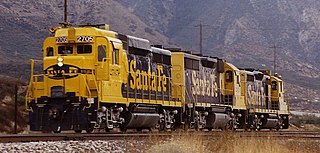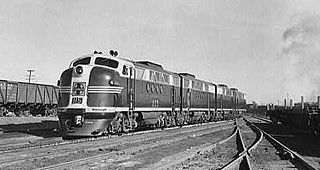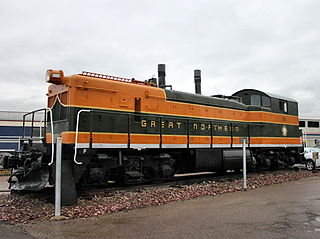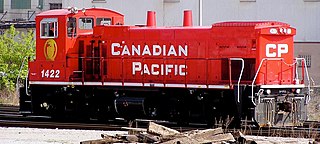
A bogie is a chassis or framework that carries a wheelset, attached to a vehicle—a modular subassembly of wheels and axles. Bogies take various forms in various modes of transport. A bogie may remain normally attached or be quickly detachable ; it may contain a suspension within it, or be solid and in turn be suspended ; it may be mounted on a swivel, as traditionally on a railway carriage or locomotive, additionally jointed and sprung, or held in place by other means.
The AAR wheel arrangement system is a method of classifying locomotive wheel arrangements that was developed by the Association of American Railroads. Essentially a simplification of the European UIC classification, it is widely used in North America to describe diesel and electric locomotives. It is not used for steam locomotives, which use the Whyte notation instead.

The EMD GP30 is a 2,250 hp (1,680 kW) four-axle diesel-electric locomotive built by General Motors Electro-Motive Division of La Grange, Illinois between July 1961 and November 1963. A total of 948 units were built for railroads in the United States and Canada, including 40 cabless B units for the Union Pacific Railroad.

EMD E-units were a line of passenger train streamliner diesel locomotives built by the General Motors Electro-Motive Division (EMD) and its predecessor the Electro-Motive Corporation (EMC). Final assembly for all E-units was in La Grange, Illinois. Production ran from May 1937, to December, 1963. The name E-units refers to the model numbers given to each successive type, which all began with E. The E originally stood for eighteen hundred horsepower, the power of the earliest model, but the letter was kept for later models of higher power.

The EMD FT is a 1,350-horsepower (1,010 kW) diesel-electric locomotive that was produced between March 1939 and November 1945, by General Motors' Electro-Motive Corporation (EMC), later known as GM Electro-Motive Division (EMD). The "F" stood for Fourteen Hundred (1400) horsepower and the "T" for Twin, as it came standard in a two-unit set. The design was developed from the TA model built for the C,RI&P in 1937, and was similar in cylinder count, axle count, length, and layout. All told 555 cab-equipped ”A” units were built, along with 541 cabless booster or ”B” units, for a grand total of 1,096 units. The locomotives were all sold to customers in the United States. It was the first model in EMD's very successful F-unit series of cab unit freight diesels and was the locomotive that convinced many U.S. railroads that the diesel-electric freight locomotive was the future. Many rail historians consider the FT one of the most important locomotive models of all time.

EMD F-units are a line of diesel-electric locomotives produced between November 1939 and November 1960 by General Motors Electro-Motive Division and General Motors-Diesel Division. Final assembly for all F-units was at the GM-EMD plant at La Grange, Illinois, and the GMDD plant in London, Ontario. They were sold to railroads throughout the United States, Canada and Mexico, and a few were exported to Saudi Arabia. The term F-unit refers to the model numbers given to each successive type, all of which began with the letter F. The F originally meant "fourteen", as in 1,400 horsepower (1,000 kW), not "freight". Longer EMD E-units for passenger service had twin 900-horsepower (670 kW) diesel engines. The E meant "eighteen" as in 1,800 horsepower (1,300 kW). Similarly, for early model EMD switchers, S meant "six hundred" and N meant "nine hundred horsepower".

The EMD F9 is a 1,750 horsepower (1,300 kW) Diesel-electric locomotive produced between February 1953 and May 1960 by the Electro-Motive Division of General Motors (EMD) and General Motors Diesel (GMD). It succeeded the F7 model in GM-EMD's F-unit sequence. Final assembly was at GM-EMD's La Grange, Illinois plant. The F9 was also built in Canada by General Motors Diesel at their London, Ontario plant. A total of 101 cab-equipped lead A units and 156 cabless booster B units were built. The F9 was the fifth model in GM-EMD's highly successful "F" series of cab unit diesel locomotives.

The EMD TR1 was a two-unit "cow-calf" diesel locomotive built by General Motors Electro-Motive Division of La Grange, Illinois, in 1941. Two pairs were built for the Illinois Central Railroad, the only purchaser.

The EMD NW3 was a 1,000 hp (750 kW) road switcher diesel-electric locomotive built by General Motors Electro-Motive Division of La Grange, Illinois between November 1939 and March 1942. A total of seven were built for the Great Northern Railway, the sole original purchaser; they were originally numbered #5400-5406 and later renumbered #175-181.

The EMD NW5 was a 1,000 hp (750 kW) road switcher diesel-electric locomotive built by General Motors Electro-Motive Division of La Grange, Illinois between December 1946 and February 1947.

The EMD MP15, sometimes referenced as MP15DC, is a 1,500 hp (1,119 kW) switcher-type diesel–electric locomotive model produced by General Motors' Electro-Motive Division between 1974–1980. It was equipped with a V12 12-645E engine sporting a Roots blower. The length was either 47 ft 8 in (14.53 m) or 48 ft 8 in (14.83 m) depending on the build date.

An EMD SW1200 is a 4 axle diesel switcher locomotive built by General Motors Electro-Motive Division between January 1954 and May 1966. Power is provided by an EMD 567C 12-cylinder engine which generates 1,200 horsepower (890 kW). Additional SW1200 production was completed by General Motors Diesel in Ontario, Canada, between September 1955 and June 1964.

The EMD MP15AC is a 1,500 hp (1,120 kW) diesel switcher locomotive built by General Motors' Electro-Motive Division between August 1975 and August 1984. A variant of the EMD MP15DC with an AC-DC transmission, 246 examples were built, including 25 for export to Mexico, and four built in Canada.

The EMD GP15-1 is a 4-axle diesel-electric locomotive built by General Motors Electro-Motive Division between June 1976 and March 1982. Intended to provide an alternative to the rebuilding programs that many railroads were applying to their early road switchers, it is generally employed as a yard switcher or light road switcher. This locomotive is powered by a 12-cylinder EMD 645E engine, which generates 1,500 hp (1,119 kW). The GP15-1 uses a 50-foot-9-inch (15.47 m) frame, has a wheelbase of 29 ft 9 in (9.07 m) and has a length over couplers of 54 ft 11 in (16.74 m). A total of 310 units were built for American railroads. A number of GP15-1s remain in service today for yard work and light road duty. The radiator section is similar to those found on the EMD SD40T-2 and EMD SD45T-2 "tunnel motors," leading some observers to incorrectly identify the units as such or as GP15Ts, and giving them the nickname "baby tunnel motors".

An EMD GP40X is a 4-axle diesel-electric locomotive built by General Motors Electro-Motive Division between December 1977 and June 1978. Power for this unit was provided by a turbocharged 16-cylinder EMD 645F engine which could produce 3,500 horsepower (2,610 kW). 23 examples of this locomotive were built for North American railroads. This unit was a pre-production version meant to test technologies later incorporated into EMD's 50-series locomotives GP50 and SD50.

The Blomberg B is a 2-axle bogie that was introduced by EMD in 1939 with the FT locomotive series; the original "B" version plus later "M" and "X" versions were quite successful and became standard equipment on a multitude of locomotive models. They are easily identified by prominent "swing hangers" on each side which widen the effective spring base and provide a better ride. EMD literature refers to this truck as the "2 Axle Outside Swing Hanger;" informally it is named after EMD designer Martin Blomberg; this design evolved as an abbreviation of the preceding 3-axle design from the E-units; see U.S. Patent 2,189,125 filed on Jan 29, 1938 and granted on Feb 6, 1940. As of 2022 Blomberg B trucks are common sights under operating locomotives throughout North America.

The "Beep" is an individual switcher locomotive built in 1970 by the Atchison, Topeka and Santa Fe Railway at its Cleburne, Texas, workshops. Technically a rebuild, the Beep originally entered service on the Santa Fe as a Baldwin Model VO-1000. Following its successful CF7 capital rebuilding program, the company hoped to determine if remanufacturing its aging, non-EMD end cab switchers by fitting them with new EMD prime movers was an economically viable proposition. The conversion procedure proved too costly and only the one unit was modified. In 2008-2009, this locomotive was retired and stored operational at Topeka, Kansas. In May 2009 the unit was donated to the Western America Railroad Museum in Barstow, California.

The GE BQ23-7 was a model of diesel locomotive manufactured by General Electric, a variant of the B23-7 built between 1978 and 1979. Mechanically identical to a regular B23-7, but equipped with an enlarged operating cab for accommodating the train crew, thus making a case for eliminating the caboose from the rear of freight trains. SCL no.5130-5139 were the only ones built. Following a practice dating back to ACL and SAL U30Bs of 1967, SCL's 10 BQ23-7s and 30 standard B23-7s were delivered riding on reconditioned Blomberg trucks from EMD trade-ins.

The EMD 567 is a line of large medium-speed diesel engines built by General Motors' Electro-Motive Division. This engine, which succeeded Winton's 201A, was used in EMD's locomotives from 1938 until its replacement in 1966 by the EMD 645. It has a bore of 8+1⁄2 in (216 mm), a stroke of 10 in (254 mm) and a displacement of 567 cu in (9.29 L) per cylinder. Like the Winton 201A, the EMD 645 and the EMD 710, the EMD 567 is a two-stroke engine.
Martin Petrus Frederik Blomberg was an American engineer of Swedish origin. He became well known for the development of the truck frame for the diesel-electric locomotives of the Electro Motive Division (EMD).


















